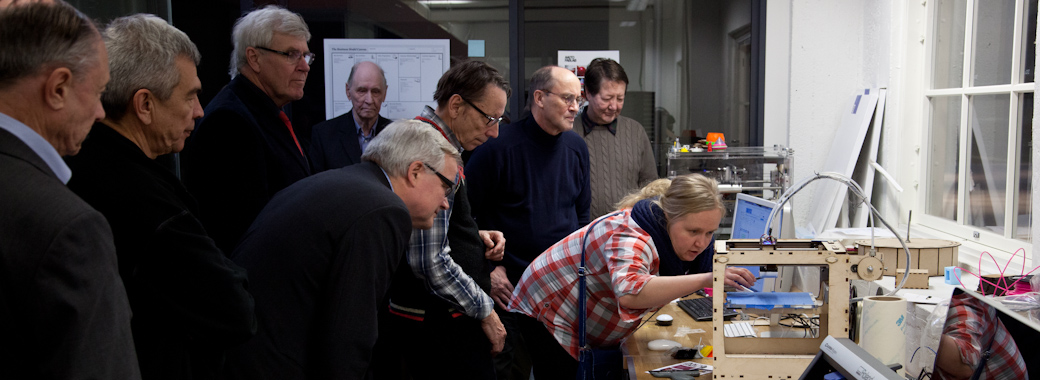Median murros – a new multidisciplinary course on media and communication
Media Factory will offer a course (3 cr) for the bachelor’s level. The aim of the course is to introduce students to current topics in media and communication. The course is introductory in nature and consists of lectures and group assignments. The course will focus on six thematic entities that closely reflect media phenomena. The course will take place in October-November 2009, and is open for all Aalto students. The course is taught in Finnish.
Course description (only in Finnish)
Median murros 1 op + 2 op
Opettajat
Vastuuopettaja Mikko Villi
Osaamistavoitteet
Aalto-yliopiston media-alan opetusta ja tutkimusta integroiva Media Factory tarjoaa median ajankohtaisia muutoksia käsittelevän opintojakson. Opintojakso on suunnattu kaikille Aalto-yliopiston muodostavien kolmen korkeakoulun opiskelijoille.
Opintojakson suoritettuaan opiskelija tuntee median käsitteeseen líittyviä merkityksiä ja jäsennyksiä, erityisesti Aalto-yliopiston tutkimuksen ja opetuksen kontekstissa. Lisäksi opiskelija oppii analysoimaan muuttuvaa mediaa sekä tunnistamaan vallitsevia kehityskulkuja. Opintojaksolla tärkeässä osassa ovat harjoitustyöt, joissa vertaisoppimisen avulla pyritään hahmottamaan tärkeitä mediaan liittyviä kysymyksiä sekä tuottamaan lyhyt audiovisuaalinen esitys verkkoon. Opintojaksolla toteutetaan Media Factoryn hands-on-minds-on lähestymistapaa oppimiseen, jossa perinteinen luento-opetus yhdistetään konkreettiseen tekemiseen.
Sisältö
Opetuksen keskiössä ovat ajankohtaiset muutokset mediassa. Opintojaksolla käsiteltäviä teemoja ovat media käsitteenä, uusi media ja mediateknologia, visuaalisuus mediassa sekä sosiaalinen media ja julkaisemisen muutokset. Opintojaksolla esitellään myös Media Factoryn tutkimuksen painopistealueita (Cross-media, Enactive social media and gaming). Opiskelijoiden muodostamat ryhmät pureutuvat opintojakson aikana em. alueisiin nivoutuviin teemoihin.
Suoritustavat
Opintojakson voi suorittaa osallistumalla luennoille ja kirjoittamalla niiden pohjalta yksilötyönä esseen (1 op). Lisäksi opiskelija voi osallistua harjoitustyöryhmiin (2 op). Harjoitustyövaiheeseen osallistumisen edellytyksenä on luento-osuuden samanaikainen suorittaminen.
Harjoitustyövaihetta varten opiskelijat jaetaan 3-4 hengen ryhmiin, jotka ohjatusti työstävät harjoitustyön. Työ toteutetaan 2-5 minuutin videoesityksenä. Harjoitustyöt laitetaan julkisesti esille verkkoon. Pohjustuksena videotyöskentelylle järjestetään kaksi luentoa audiovisuaalisesta kerronnasta.
Työmäärä toteutustavoittain
Luento-osuus (1 op): luennot 12 h ja essee 15 h.
Harjoitustyövaihe (2 op): luennot 4 h, ryhmien kokoontumiset 15 h, harjoitustöiden koostaminen 35 h.
Oppimateriaalit
Ilmoitetaan kurssin alkaessa.
Arvostelu
Luento-osuus (1 op) arvostellaan esseen perusteella, kunkin korkeakoulun soveltaman arvosteluasteikon mukaan. Harjoitustyövaihe (2 op) arvostellaan asteikolla hyväksytty/täydennettävä. Opintojakson kokonaisarvosana määräytyy luento-osuuden perusteella.
Esitiedot
Kurssi on suunnattu BA- ja kandidaattivaiheen opiskelijoille. Erityisiä esitietoja tai pohjasuorituksia ei vaadita.
Opetuskieli
Suomi
Opetuspaikka
Helsingin Kauppakorkeakoulu, tarkempi paikka ilmoitetaan myöhemmin.
Aikataulu
Luento-osuus: luennot torstaisin 1.10. – 5.11.2009 klo 16-18. Essee tulee palauttaa 23.11.2009 mennessä.
Harjoitustyövaihe: luennot keskiviikkoina 14.10. ja 21.10.2009 klo 16-18. Harjoitustöiden tulee olla verkossa esillä 23.11.2009.
Ilmoittautuminen
Ilmoittautuminen sekä luento- että harjoitustyöosuudelle 14.9.2009 mennessä, ilmoittautuminen tapahtuu WebOodissa.
 by Johanna Pentikäinen
by Johanna Pentikäinen

 by Maija Töyry
by Maija Töyry